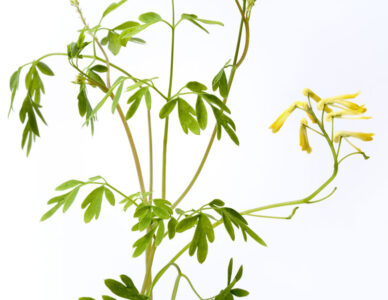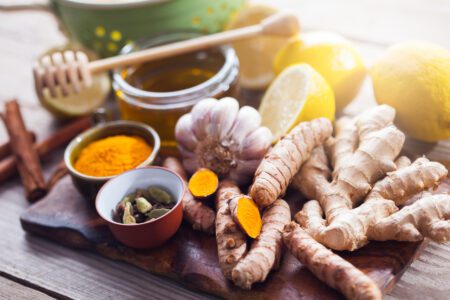“Is this the real curry plant where curry seasoning comes from?” the lady asked, holding a little pot of herbs tenderly in her hand.
“Yes, that’s where Indian curries get their flavor,” the sales clerk said with a smile.
Next to me at a flower and garden show was a plant nursery booth, selling many varieties of herbs. I wasn’t surprised at the clerk’s answer, but I was sorry that she was misleading her customer.
The truth is, the plant called “curry” isn’t actually an edible plant at all. Helichrysum italicum, sometimes listed as H. angustifolium, is the herb commonly sold as a curry plant by well-meaning nurseries and garden centers. It has a warm, curry-like fragrance, but is bitter to the taste. More reputable plant sellers will tell you the plant is not edible and will encourage you to grow the plant for use in potpourris and wreaths, but not for food. For more information about this plant, check The Big Book of Herbs (Interweave, 2000) by Arthur O. Tucker and Thomas DeBaggio.
The seasoning we think of as curry is called masala in India. That seasoning makes curries, but curries differ by their ingredients just as the meaning of the word “salad” differs based on its ingredients in our culture. In India, the word kari means sauce or stew. All of these stews have the masala seasoning in common, so in past centuries people outside of India simply lumped everything together calling it curry, a variation of the word kari, for sauce.
Actual curry seasoning is a blend of ground cumin, ginger, coriander, cinnamon, turmeric, red pepper, fenugreek, allspice, black pepper, cardamom, cloves, mustard, fennel and mace. In that mix, several of the ingredients, including mustard, cumin, coriander, fennel and cinnamon, are roasted separately before being ground and added to the other ingredients. Curry is a complex seasoning that varies from region to region (nothing like the generic combination found in the grocery store), even from family to family throughout Southeast Asia. Curry seasonings are often vastly different depending on the season. During summer months, the seasoning is mixed with spices that cool the body and in winter, a different blend helps keep the body warm.
I’m not sure why plant sellers continue to sell that little Helichrysum they call curry plant. It’s a finicky, picky little plant, prone to fungal problems, webworms and other pests. It’s not hardy unless you live in Zone 7b or 8. More to the point, why consider it an herb if it’s neither edible nor medicinal?
One plant is correctly termed “curry,” and that is the curry leaf plant. It’s a shrub or small tree, native to India and into the foothills of the Himalayas, eastward to Myanmar and southern China. Botanically, it’s Murraya koenigii and is easily grown in a pot indoors and moved outside in summer, in partial shade or filtered sun. It is the primary seasoning in the South Indian dosa, a crispy, thin, rolled pancake-like bread that is served stuffed with several varieties of curry.
To cook with the true curry leaf, which is generally used fresh but also has uses when dried, first heat ghee (clarified butter) or oil to almost smoking, toss in some garlic and roast it, along with some diced onion, then toss in six or eight curry leaflets (removed from the stem). The leaves immediately sizzle and pop, releasing their unique flavor into the oil. They can then be removed, or left in the dish as the other ingredients are added.
Curry leaf is available in many Asian and Indian grocery stores nationwide and is usually found in small bundles or sold in plastic bags. The leaves will keep in the refrigerator for two or three weeks.
Before cooking, fresh curry leaf won’t really remind you of curry, but once the leaves are roasted in oil, the aroma and flavor change remarkably, and the flavor is pleasant and delicious.
Curry leaf is also used in pickles, egg dishes, chutneys and many other Asian and Indian dishes and is known as “sweet neem” in India. If you want a true curry flavor, either find a recipe for masala and mix your own, or look for the curry leaf plant (Murraya koenigii) in larger nurseries. As for that little plant commonly called “curry”(Helichrysum italicum), don’t try and squeeze curry flavor out of it. It’s just not there.
Jim Long’s book, Great Herb Mixes You Can Make (Long Creek Herbs, 2003) provides the ingredients for several authentic curry spice blends. Readers’ questions are always welcome at www.Longcreekherbs.com.








